How to Render Beef Tallow
This post may contain affiliate links. Read my full disclosure here.
We buy buy local grassfed beef in halves or quarters, so learning how to render beef tallow makes sense for our family. Even if you don’t buy in bulk, you can save fat trimmings for rendering. Waste not, want not.
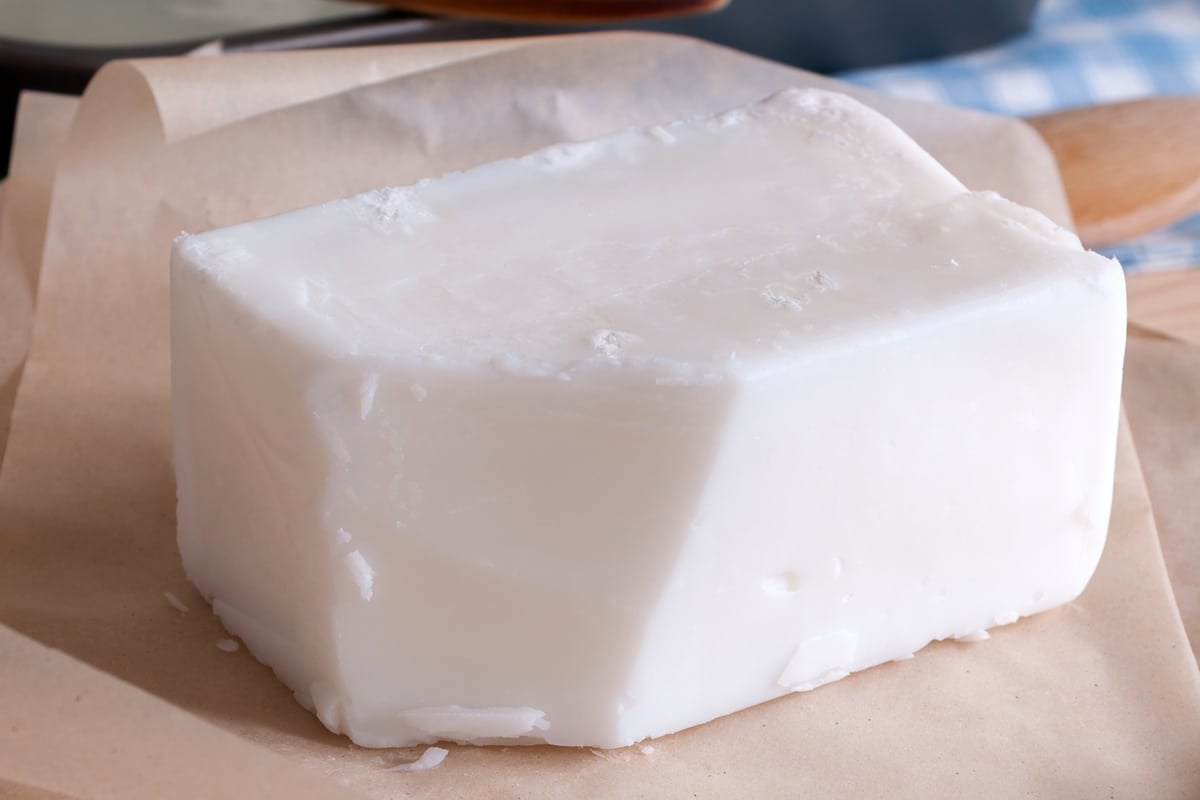
Don’t forget to check out How to Make Beef Stock to put those soup bones to use. We also teach you How to Cook a Beef Tongue.
What is Beef Tallow?
Beef tallow is a form of rendered fat, traditionally obtained from the kidney fat (called suet) or other fatty cuts of beef. Rendering beef fat means cooking it down and removing impurities to make it shelf stable.
Rendered sheep fat is also called tallow, while rendered pig fat is called lard. Rendered poultry fat is schmaltz, and rendered butter is ghee. We are fans of animal fats, and saturated fats in general, because they are natural and more shelf stable.
Tallow has been used for centuries for cooking because of its high smoke point, shelf stability, and rich flavor. (And because people didn’t waste things that were useful.) For baking, use it as a substitute for shortening. You can also use it in skincare products, soaps, and candles.
Why Use Tallow?
Tallow is a great cooking fat, adding delicious beef flavor to food such as fries. (McDonald’s used to use tallow before they switched to vegetable oils in 1990. This is why their fries don’t taste right anymore.)
- High smoke point (around 400°F / 205°C) – Ideal for frying and roasting.
- Long shelf life – You can store tallow at room temperature without it going rancid. Refrigeration and freezing will extend shelf life.
- Nutrient-rich – Contains healthy fats like conjugated linoleic acid (CLA) and fat-soluble vitamins. Stearic acid and palmitic acid, found in beef tallow and butter, are the preferred foods for the heart. Note: The healthier the beef animal, the healthier the tallow.
Step-by-Step Guide to Render Beef Tallow
Rendering tallow takes time, so it’s best to prep ahead and be patient. You’ll also want to allow time for cleanup, especially if you have a lot of tallow.
Ingredients and Tools
- Beef suet or fat trimmings
- Heavy-bottomed pot, slow cooker, or roaster
- Metal strainer and good quality cheesecloth (or old cotton t-shirt or pillowcase)
- Glass jars or containers for storage
- Knife and cutting board
- Grinder or food processor (optional)
Instructions
I’d recommend starting out with a small amount of fat your first time, say a pound or two, or scrap fat. Then you’ll have a better feeling of how to work with the fat for processing larger amounts.
1. Source Your Fat
Look for beef suet or fat trimmings, ideally from grass-fed animals for higher nutritional value. Suet is the hard fat found around the kidneys, but any excess beef fat can be used. Local butchers or grocery stores may offer suet, or you can request it when buying beef cuts.
Leaf fat from around the kidneys is easier to clean and has a milder flavor. Fat from beef cattle is white in color. The fat of dairy cows, especially Jerseys and Guernseys, is a yellow color.
If you’re buying fat in bulk from a butcher, ask if they will grind it for you. This is a HUGE timesaver for big batches.
We requested the beef fat from our bulk beef purchase. The butcher was surprised we wanted it. Then they were doubly surprised when I said I was going to eat it myself instead of feeding it to the birds. I ended up with about two five gallon buckets full.
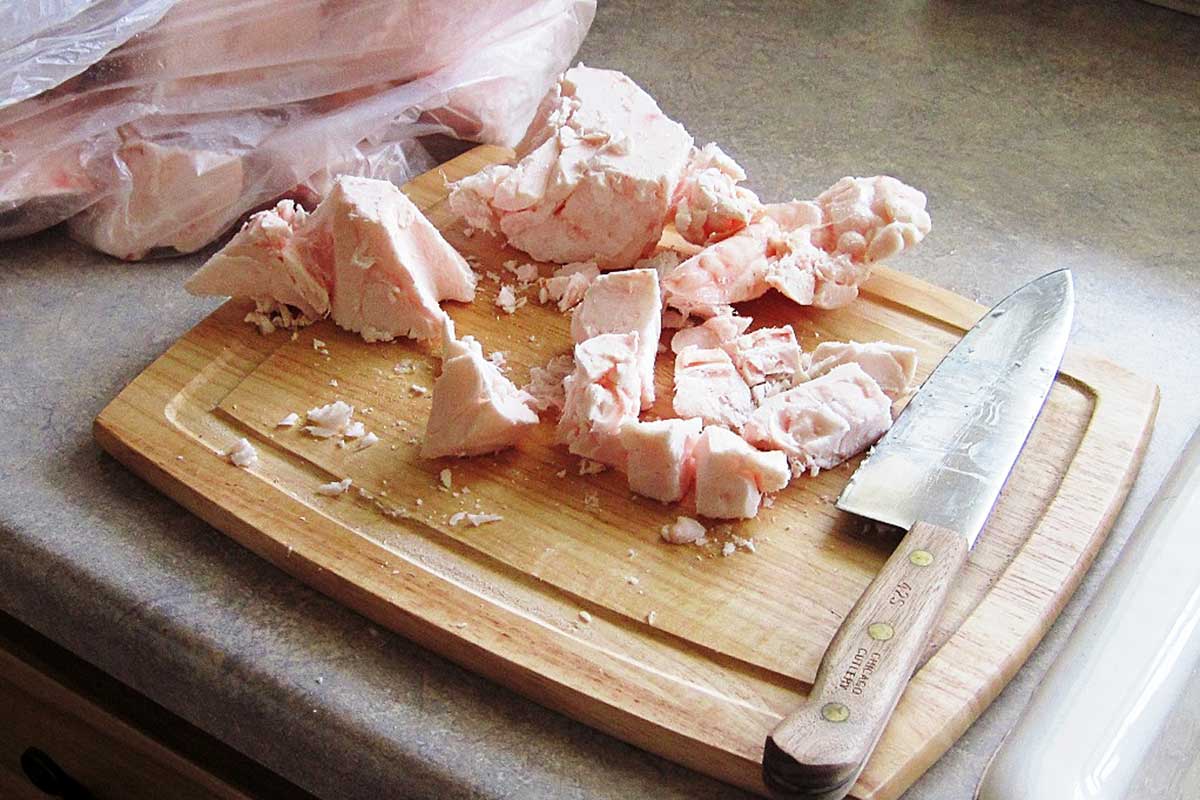
2. Prepare the Fat
Trim any meat or connective tissue attached to the fat. These bits won’t render properly and may cause the tallow to spoil faster.
Cut the fat into small pieces (about 1-inch cubes). Smaller pieces melt more quickly and evenly. That way you’re not getting some parts burning while other parts are only half-cooked. If you can grind it or process it in a food processor, it will render even faster.
For easier chopping, freeze the fat slightly beforehand, or keep refrigerated. I recommend keeping the fat cold and working in small batches. When frozen and unrefined, the fat is very hard and the connective tissue crinkles like cellophane. As it melts, it becomes sticky, almost like glue.
3. Render the Fat Slowly
You can render beef tallow on a stove top, in a slow cooker, in the oven, or outside with a propane burner. If you are processing a large amount of fat, outside is the way to go.
Some people add a little water to the bottom of the pan. I avoid adding water, because if you add it, you have to make sure that you cook it off.
When we processed several gallons at once, our house smelled beef for around three days, even with running the stove vent. It was mid-winter so I couldn’t easily air out the house.
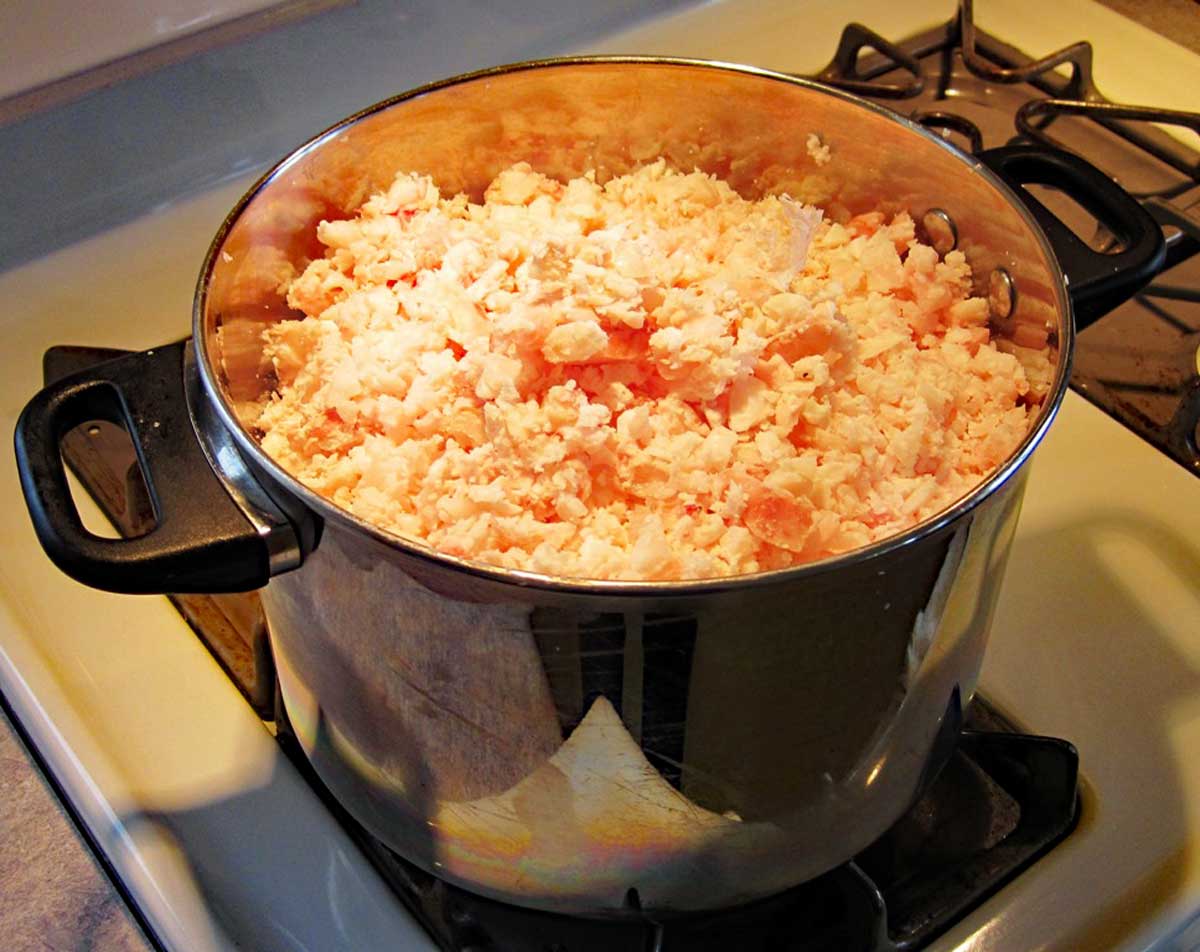
A. Stove-Top Method:
- Place the fat pieces in a heavy-bottomed stock pot over low heat.
- Stir occasionally to prevent sticking. As the fat melts, it will separate from the solids (cracklings).
- After 1-2 hours, most of the fat will have melted, and the solids will begin to brown and float to the top.
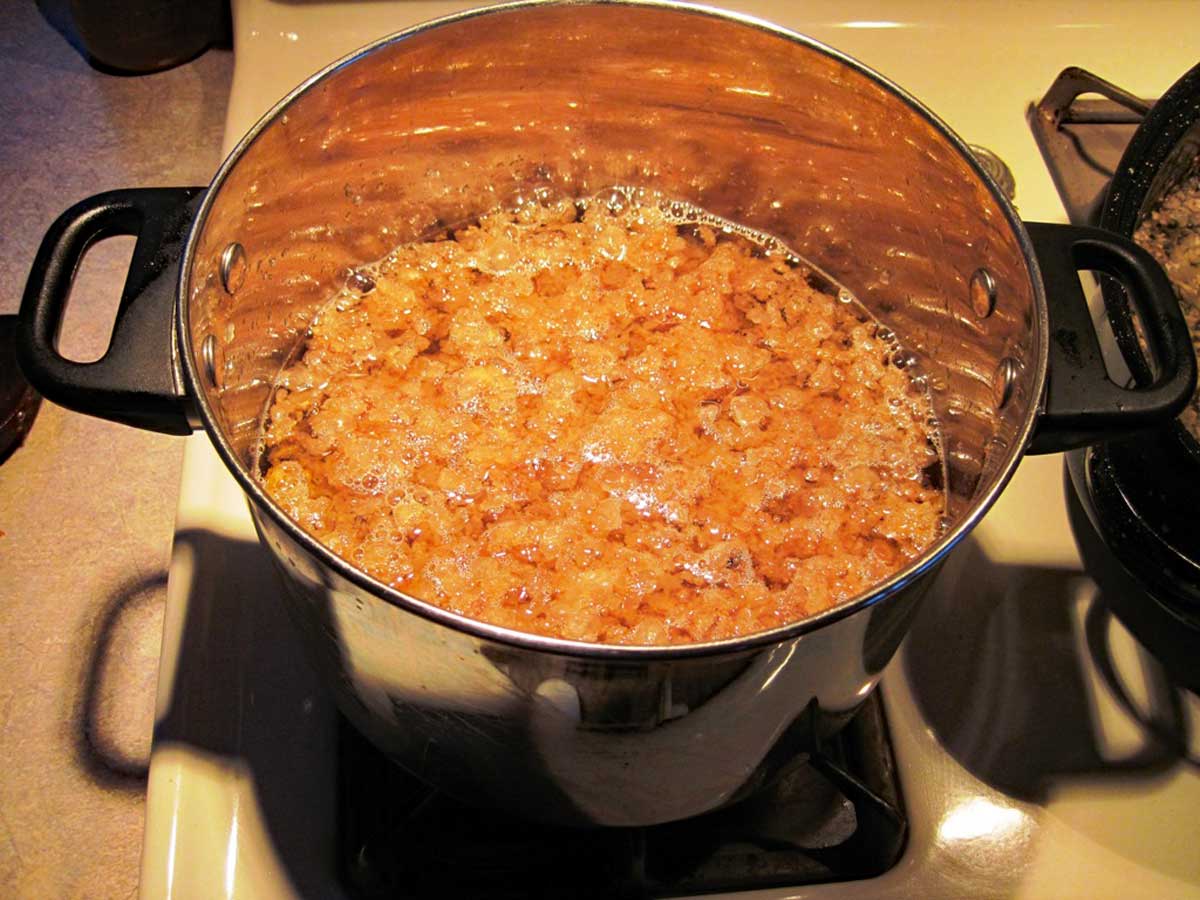
B. Slow Cooker Method:
- Add the fat to a slow cooker and set it to low.
- Stir every hour to check the progress. This method can take 4-6 hours but requires less attention.
C: Oven Method
Would you like to save this?
- Fill a roasting pan with chopped tallow and place it in an oven to low – 250° F – uncovered.
- Stir after 30 minutes, then stir every 45 minutes. Cook for 4-6 hours, or until the cracklings begin to darken.
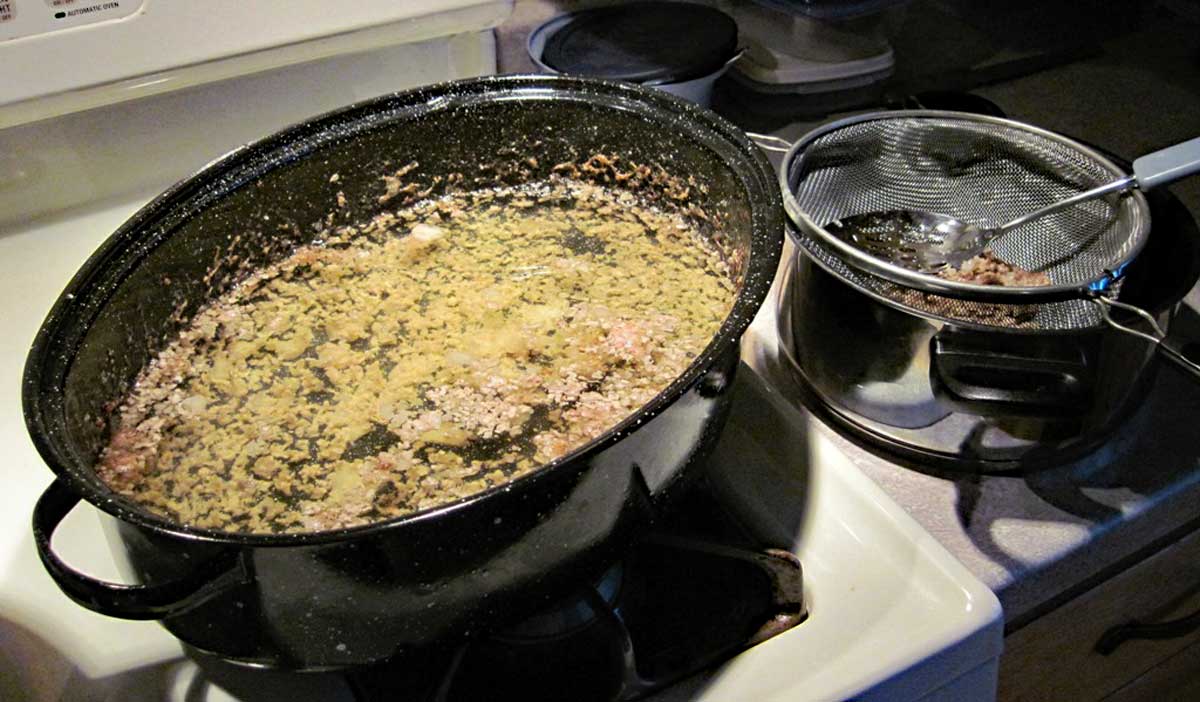
D: Outdoor Propane Burner
We have an outdoor propane burner for emergencies and outdoor cooking. It’s excellent for rendering large batches of beef tallow or lard from pork. The odor and heat stay outside.
Use a heavy bottom pot on low heat, following the same timing for stirring and cooking as the stove top method.
Rendering on the stove top and in the oven went equally well, although the pot from the stove top was easier to clean. We rendered lard outside this summer, and that also worked well.
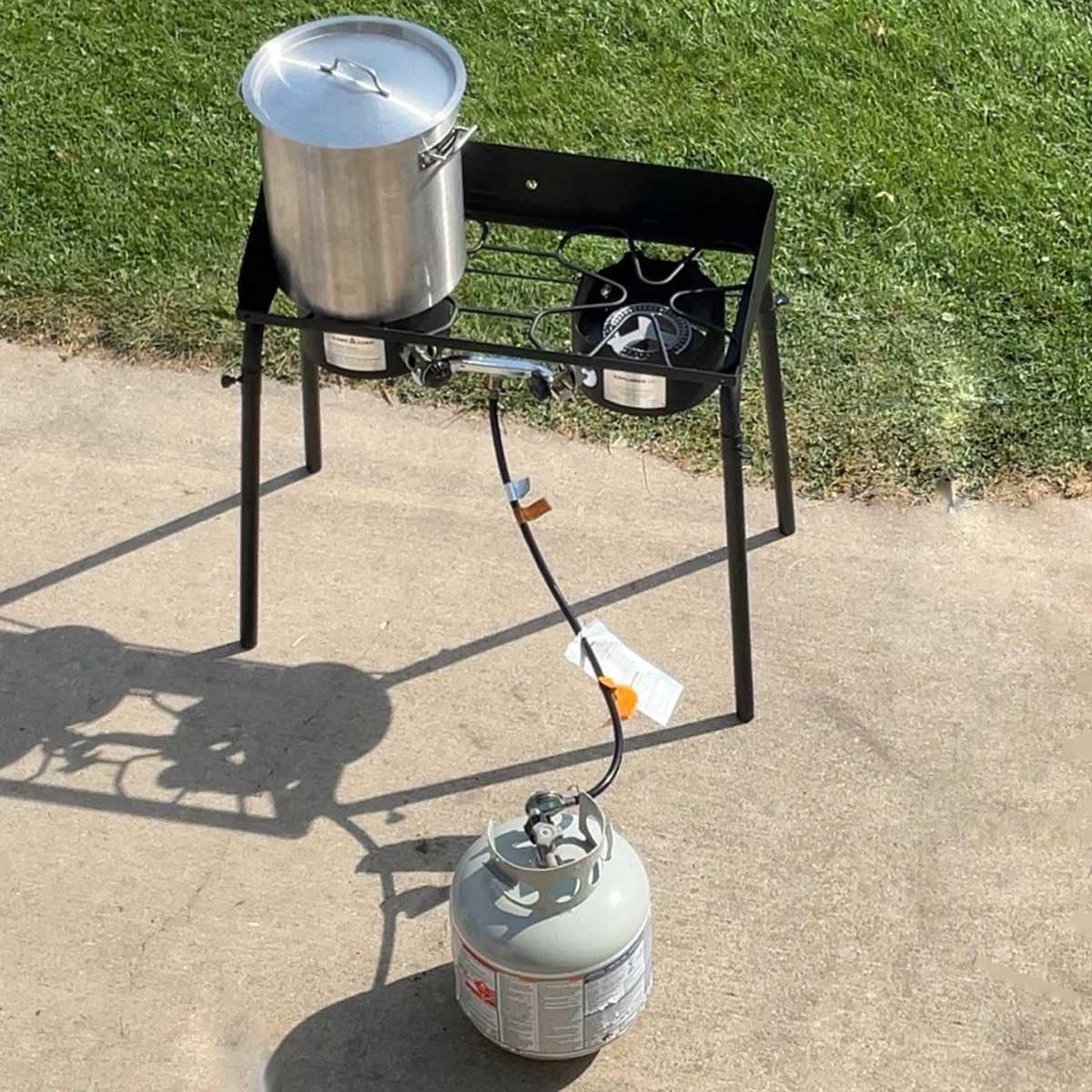
4. Strain the Rendered Fat
Once the fat is fully melted and golden, strain it through a fine mesh strainer lined with cheesecloth. This removes any remaining solids, leaving behind pure liquid tallow. An old cotton t-shirt or pillowcase also works well.
Do not use synthetic fabrics, as they shed particles. We put our filter fabric in the garbage, not in the washer, so it doesn’t clog any drains.
If you don’t have cheesecloth, coffee filters will do in a pinch. They don’t work quite as well, because they tend to clog more easily.
Be careful, as the liquid fat is extremely hot. Use heat resistant strainers and containers on a heat proof surface.
5. Cool and Store
- Allow the strained tallow to cool slightly, then pour it into clean glass jars or containers.
- Let the tallow solidify at room temperature. It turns creamy white once fully cooled.
- Store the tallow in an airtight container at room temperature or in the refrigerator or freezer for long-term storage.
I used two gallon buckets I had saved from coconut oil and a couple other freezer containers. Here’s what I ended up with before repackaging.
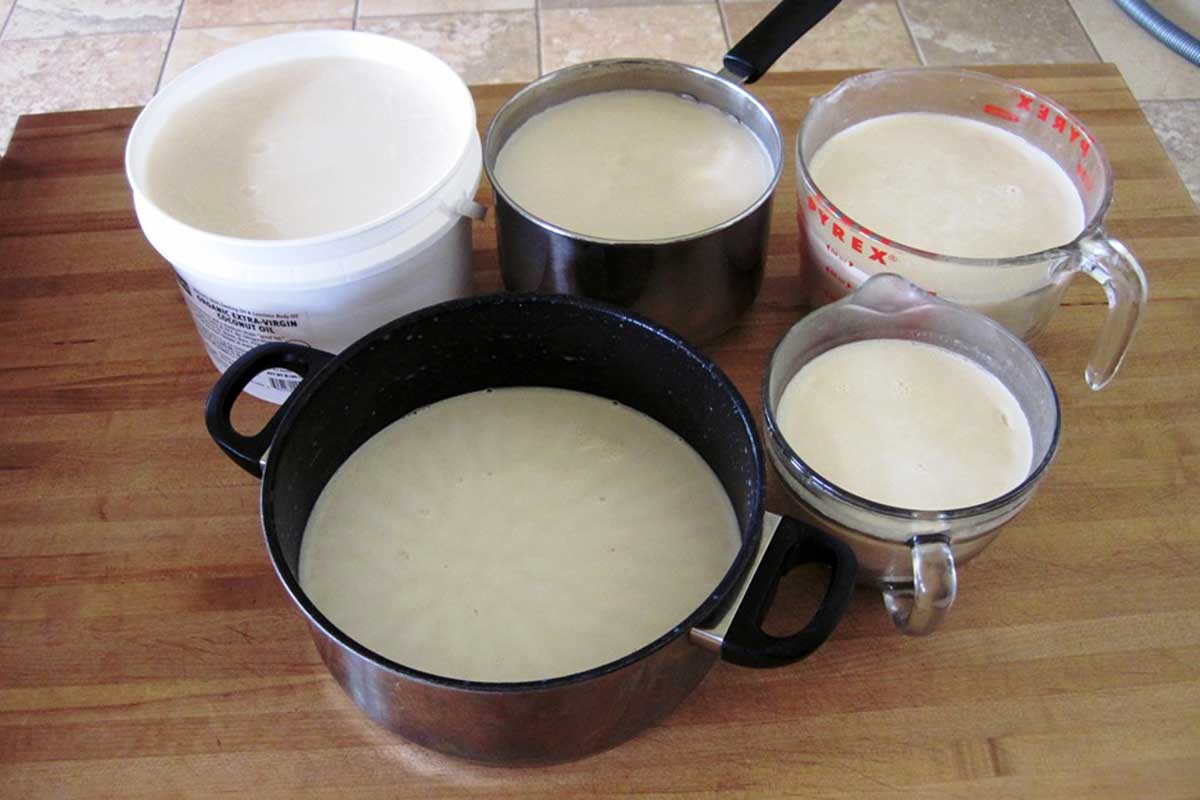
Storage note – tallow gets REALLY hard as it cools – significantly harder than lard or coconut oil. Make sure your storage containers are durable, and will hold up to some digging or scraping.
You can also pour your liquid tallow into baking pans lined with wax paper or parchment paper. Allow the tallow to cool, and then chop into blocks for storage.
Beef tallow has a unrefrigerated shelf life of 2-6 months, depending on temperature and degree of impurities. I keep mine in the refrigerator (9-12 months) or freezer (1-2 years) for extended storage.
Cleaning Tip for When You Render Tallow
A friend shared this cleanup tip for working with fatty foods:
When cleaning up, especially after sausage making (high fat), wipe everything with paper towels to remove excess fat. Then, wash in cold water, then wash again in hot, soapy water. It defies logic, but works much better.
FAQ
1. Do I need to refrigerate tallow?
Properly rendered tallow can be stored at room temperature in an airtight container for months. However, refrigerating it will extend its shelf life even further, up to a year or more.
2. Why did my tallow turn grainy or crumbly?
If the tallow cools too quickly, it can develop a grainy texture. To avoid this, let it cool slowly at room temperature before refrigerating.
3. How do I know if my tallow has gone bad?
Spoiled tallow will have an off smell, sour or rancid odor, and may develop mold if exposed to moisture. Properly rendered and stored tallow should be odorless or have a mild beefy scent.
4. Can I reuse beef tallow for deep frying?
Yes, you can use tallow for frying several times. Strain it after each use. If it develops an off odor, discard it. (Our chickens like a little fat mixed into their chicken chow.)
5. Where can I buy tallow?
If you don’t want to make it, look for grassfed beef tallow at specialty grocers or online. Epic Beef Tallow and Sulu Grass Fed Beef Tallow are two popular brands.

This article is by Laurie Neverman. Laurie grew up on a small dairy farm in northwest Wisconsin, and now lives on a 35 acre homestead in northeast Wisconsin.
She and her family combine the best of old and new to create a more sustainable lifestyle. They use solar water heating and line drying, root cellaring and freeze drying, annual gardens and permaculture. There’s always more to explore!
Last updated in 2024.


I picked as much of the meat pieces that I could from the frozen chunks of beef tallow.
Some of the frozen chunks, seem to have blood in them/ are red, so I kept those out for now. What can I do with those pieces? Im guessing the blood would ruin the tallow for cooking, etc. Can our dogs chew on them? or better to give to the poultry?
A little bit of blood won’t hurt. As you render the tallow, the blood will cook down and settle out, and then you filter it along with any other impurities.
I wouldn’t give too much to the dogs at once, or they might get diarrhea, but a little should be fine. With the chickens, I’d give them small amounts, too, so it’s supplementing their main food, not replacing it.
Some videos I watched had to scrape off impurities and then recook 3 times to get rid of the impurities. Does it make a difference if it’s fat with some meat particles or if it’s suet?
The cleaner your fat chunks when you start, the clearer your final product will be with less filtering. I’ve seen a lot of different rendering variations, but we were happy with the quality of the finished product with one cooking and filtering through a metal strainer lined with good quality cheesecloth. (Not the thin stuff that lets everything go right through.) Using an old cotton t-shirt or pillowcase works well, too. Plan on tossing or composting whatever fabric you use to line the strainer, because it will get well-coated with fat. Don’t filter with synthetic fabrics. They shed microplastics.
Thank you for this timely article. We bought 1/2 cow including the suet, and I was just planning to research how to render beef tallow when this article was posted. I hope to make my grandma’s Suet Pudding for the holidays, and wanted to purify and use the rest for cooking due to tallow’s heat stability.
Enjoy your grandmother’s recipe. That’s wonderful that you’re giving it a try.
Another helpful, easy-to-read, first-hand experience article.
After rendering, can the beef tallow be canned for longer term storage? I see that it can be frozen, refrigerated, or left on a shelf for progressively shorter periods of time. Thank you.
Officially or unofficially?
There’s no recommended canning method for tallow on the National Center for Home Food Preservation website. The closest thing they have is mincemeat pie filling, which contains suet. They process quarts in a dial gauge canner for 90 minutes and 11 lbs of pressure, or 90 minutes at 10 lbs pressure with a weighted gauge canner.
Recommendations on the internet are all over the place. One site says 25 minutes at 10 pounds of pressure.
I packed hot lard in sterilized jars and kept the ones that sealed well in the root cellar for the better part of a year. If fats start to go rancid, they will have an off odor and flavor.
You want to make sure to filter the fat to keep out any meat bits, which will speed up spoilage.
Could you use a crock pot?
Yes, just make sure there is ventilation. Rendering tallow will produce a very distinctive beefy smell.
I’ll be picking up about 30 pounds of tallow at the butcher’s on Tuesday….it’ll be my first time trying to render fat on this scale. :o) Of course, the first place I thought to look for instructions was here. Thanks!
thanks for thinking of me! Give yourself plenty of time to tackle that much tallow. Your hands are going to be so soft by the time you’re done!
Ack – Jo! Now you're forcing me to be sociable again. 😉
Hi Marillyn! I'll be taking a peek at what you're up to. 🙂 Isn't the internet handy?
motherhen – yep! I ended up with close to three gallons of tallow, so we should be well set until next fall.
What a lot of gross work, but now you're done for a while! WTG.
Wow! This is great! Thanks so much… I blog at Just Making Noise. I see you have pretty much all my favorite blogs on your blogroll too!
Tami – a couple of hours? I didn't time it exactly. We started in the early afternoon and I finished cleaning up the last of the mess around 10pm. We had to stop and I ran and got the grinder,and I stopped and made dinner. I finished up the last pot full on my own after dinner.
Pamela, congrats on the grandbaby to be. I hope your back mends soon. I didn't realize I had captured Dunc like that until I looked at the photos – too funny. 🙂
FANTASTIC Laurie!!!!
We have friends that will be turning out 2-3 grass fed beef, lamb and chickens this summer. So hoping we can afford to buy from them.
I'm a bit out of the loop with my postings lately.
So busy with knitting for Grand Baby due in April, but shower is in 1 1/2 weeks. Shower took us by surprise, just announced a week ago and we were under the impression that our daughter in law was firm on no shower..someone apparently changed her mind. Had some delays now with my knitting due to hurting my back last weekend hauling firewood in. Knitting slowed down to heating pad therapy and dosing off with the heat. Have to bind a faux sheep fleece blanket for the baby, also….though I'll do a posting about it all when I do get done.
By the way I love the look on your sons face chopping tallow…just to cute!!
How long did it take for the tallow to render on the stove?